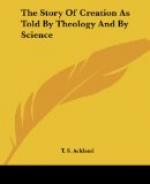In these two verses there are one or two points which call for notice. In the first place, the creatures mentioned are divided into three classes, of which two, cattle and the beast of the earth, are tolerably clear in their general significance, though their extent is not determined. The third is denoted by a word which had already been employed to describe the work of the fifth day, and is translated in our version “creeping thing.” The probability seems to be that it has reference to such classes of animals as the smaller rodentia, and the mustelidas, whose motions may be appropriately described by the word “creeping.” That it denotes four-footed creatures has already been pointed out. The next point is, that in each case the singular is used; in the case of the domestic animals this fact is lost to the English reader by the use of the collective noun “cattle.” Of course it is a common usage, to denote a class of animals by a singular noun used generically, but the statements of the passage would also be justified if one pair only of each of the three types specified were called into existence at first. It is also to be noticed that while the word [Hebrew script], the earth is used to define the wild beast; another word, [Hebrew script] the ground, is applied to the “creeping thing.” There is probably a reason for this, though it may not at present be apparent.
When we turn to the Geological record, we find that the period of the chalk was followed by the deposition of the tertiary strata. During the upheaval of the chalk these strata seem to have been gradually laid down in its hollows, and around its edges. They extend from the London clay upward to the crag formations which appear on the Eastern coast of England at intervals from Bridlington to Suffolk. In these strata we see signs of an approach to the existing state of things. As we ascend through them, a gradually increasing number of the fossil shells are found to be specifically identical with those which at present inhabit the ocean.
Another characteristic of this period is the abundance of fossil remains of mammalia; but in this case, although the remains are evidently, in many cases, those of creatures nearly allied to those now existing, they are not identical, very great modifications both of bulk and of minor structural details having taken place. One very important point of difference is the vastly superior bulk of these ancient animals: a good illustration of which may be seen in the skeletons of the mammoth and of the modern elephant, which are placed near each other in the British Museum. Many of these animals appear not to have become extinct till long after the appearance of man.




